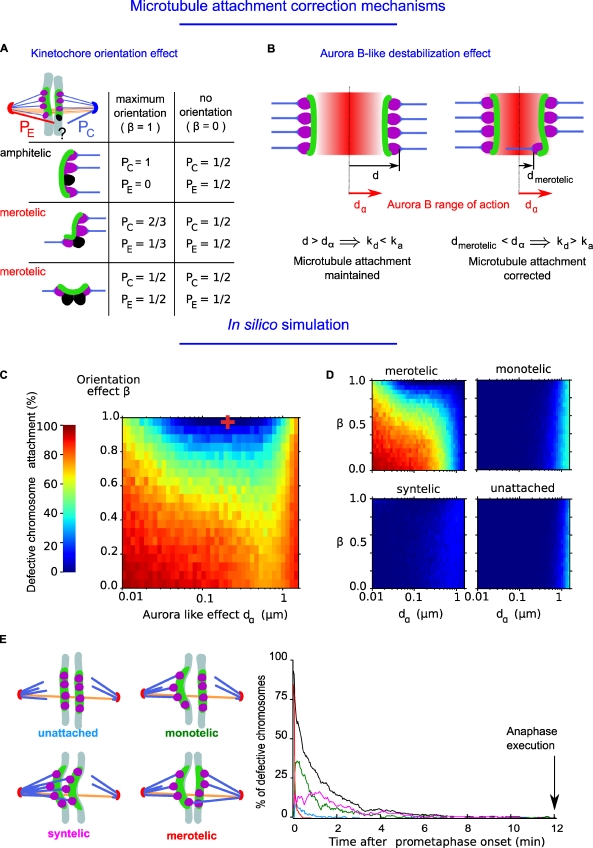Figure 3.
Relative contributions of kinetochore orientation effect and Aurora B–like activity to error correction. (A) Diagram illustrating the effect of a kinetochore orientation effect on the probability that an empty microtubule attachment site (in black) will be attached erroneously (in red, probability [PE]) or attached correctly (in blue, probability [PC]). As described in the Materials and methods, the kinetochore orientation effect is adjusted with a parameter β. Orientation effect is maximal when the parameter β = 1, and there is no orientation effect when β = 0. Several possibilities are shown, and the corresponding probabilities are indicated either for an amphitelic attachment (with a single unattached site) or a merotelic attachment (with one or two unattached sites). (B) Diagram illustrating the range of action of an Aurora B–like destabilization effect (dα; red gradient in between the two kinetochores) and its effect on the detachment rate (kd). When a merotelic kinetochore is localized in the range of action of the Aurora B–like destabilization effect, the distance from the position of the kinetochore binding site to the center of the kinetochore pair (dmerotelic) is lower than dα. Therefore, the probability for a microtubule to detach is high. Oppositely, if the position of the kinetochore binding site is not in the range of action of Aurora B–like destabilization effect, the distance (d) is higher than dα, and the probability for a microtubule to detach is low. (C) Simulations of the relative contributions of an Aurora B–like effect (dα) and kinetochore orientation effect (β) to the frequency of attachment defects. The percentage of chromosomes showing an attachment defect was measured 12 min after initiation of mitosis (average duration of metaphase, n = 45,100 simulations). The red cross indicates the optimum parameter values for Aurora B–like destabilization effect and kinetochore orientation effect at which there are the fewest chromosome attachment defects. (D) Simulations of the relative contributions of an Aurora B–like effect (dα) and kinetochore orientation effect (β) to the frequency of merotelic, monotelic, syntelic, and unattached. (E) Timing of correction of chromosome attachment defects (percentage) using the optimal value of correction mechanisms. The different types of erroneous attachments are shown: merotelic, monotelic, syntelic, unattached, and total defects (black).

